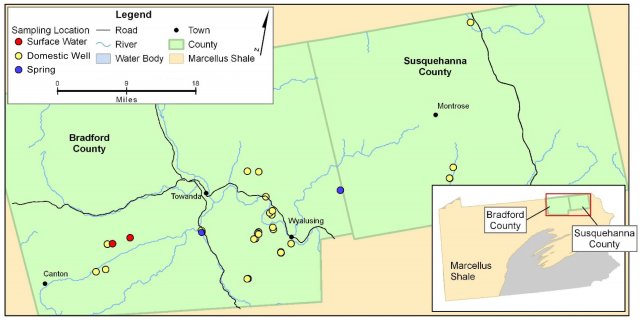Retrospective Case Study in Northeastern Pennsylvania
Case Study Background
EPA conducted a retrospective case study in northeastern Pennsylvania to investigate reported instances of contamination of drinking water in areas where hydraulic fracturing had occurred. While this case study did not definitively link specific contamination pathways to the hydraulic fracturing process, the findings helped the EPA to identify vulnerabilities to drinking water resources from fluid and gas migration associated with hydraulic fracturing activities such as: well construction and integrity, and surface activities (well pads and associated spills).
- Report: Retrospective Case Study in Northeastern Pennsylvania (PDF)
- Fact Sheet: Northeastern Pennsylvania Retrospective Case Study
Key Findings
- No evidence of impacts on homeowner wells and springs from flowback water, produced water, or injected hydraulic fracturing fluids was found in the study.
- Background data showed that methane is naturally occurring in the study area; however, using multiple lines of evidence EPA concluded that up to nine of the 36 drinking water wells are impacted by stray gas (methane and ethane) associated with nearby hydraulic fracturing activities.
- EPA detected elevated levels of chloride and total dissolved solids in a pond in the study area. This pond is adjacent to a well pad that had reported releases of fluids and/or solids in 2009. This pond is not used as a drinking water source.
State Activities at the Case Study Location
The Pennsylvania Department of Environmental Protection (PADEP) took a multitude of steps to investigate and protect drinking water resources in response to complaints, including entering into a Consent Order Agreement with the company to replace impacted water supplies and remediate gas wells, fining the operator for gas migration, and overseeing a Corrective Action Plan to evaluate the mechanical integrity of area gas wells. PADEP continues to monitor the situation and have provided alternate drinking water when necessary. They also issued four notices of violation relating to releases and contamination at a pond, which was not being used as a drinking water source, and issued one Consent Assessment of Civil Penalty to date.
Sampling Activities
EPA completed three rounds of water sampling from October 2011 to May 2013 from domestic wells, springs, and surface water locations. Sampling locations were selected primarily based on homeowner-specific concerns and complaints regarding potential adverse impacts on their well water from drilling and/or other processes related to hydraulic fracturing.

